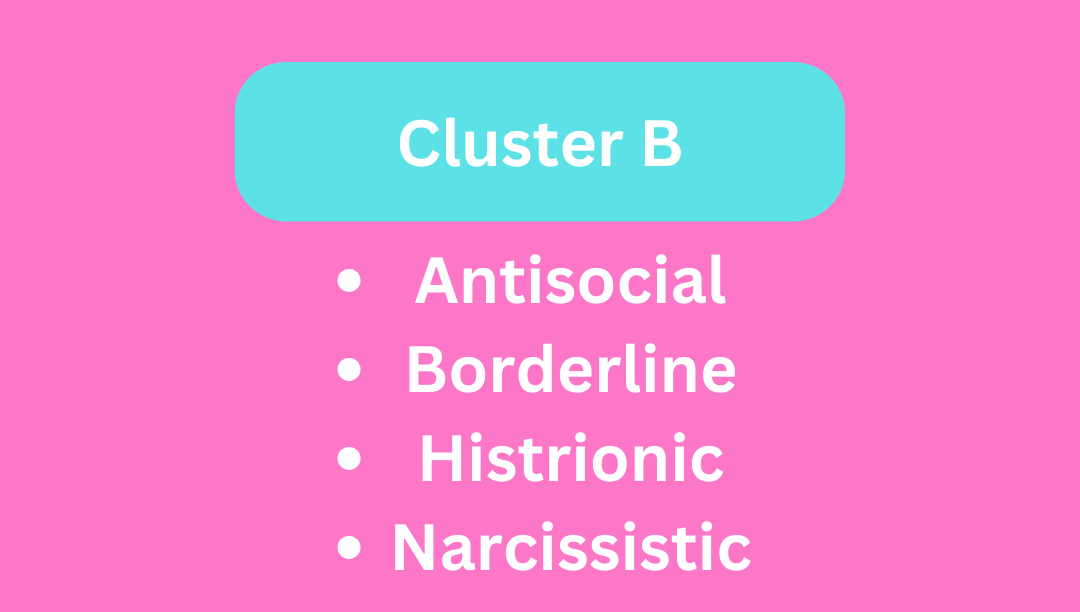Cluster B disorders, characterized by inappropriate, volatile emotionality and frequently unpredictable behavior, encompass several specific personality disorders. These include antisocial personality disorder, known for its disregard for social norms, borderline personality disorder with its intense mood swings, histrionic personality disorder marked by attention-seeking behaviors, and narcissistic personality disorder typified by feelings of grandiosity and a lack of empathy.
Traits of Cluster B personality disorders
Cluster B is also sometimes known as the ‘wild’ cluster due to the emotional instability associated with each disorder. Indeed one of the core patterns linking all patients Cluster B together is their sense that their emotions are unbalanced with feelings of sadness, dissatisfaction, anger, irritability, and emptiness. Common in the involvement of extreme emotional states makes these disorders commonly misdiagnosed as mood disorders like depression and bipolar disorder. However, it’s important to realize that Cluster B personality disorders aren’t defined by any single mood state but rather by a tendency towards negative emotions of all kinds. This tendency maps to the ocean trait of neuroticism, which is a characteristic found in all four of this personality disorder.
What is Cluster B?
Cluster B comprises a total of four personality disorders, each presenting a unique set of characteristics and symptoms. These disorders are antisocial personality disorder, borderline personality disorder, histrionic personality disorder, and narcissistic personality disorder, each with its distinct challenges and implications for those affected.

Each personality disorder presents a unique set of behaviors that individuals exhibit regularly. Those affected may experience a persistent urge for attention, feeling compelled to seek it incessantly. Moreover, it’s typical for such individuals to display intermittent indications of at least one additional personality disorder alongside the primary diagnosis. This complex interplay of behaviors underscores the intricate nature of these disorders and the challenges they present in diagnosis and treatment.
Some people who have been diagnosed with cluster B illnesses frequently are unaware of how much their feelings of dissatisfaction are caused by their behaviors. Cluster B illnesses can be effectively treated with therapy and, in certain situations, medication. However, understanding why the patient is seeking help in the first place is an important part of the therapeutic process. Sadly, there are times when people with cluster B illnesses are reluctant to get help, mostly because they don’t think there is anything wrong with their conduct or how it affects their health. To fully participate in the healing process, patients must understand the connection between their actions and the results of their actions.
Antisocial Personality Disorder
Antisocial simply means not enjoying being in the company of others and preferring to spend most of the time alone.
At its core, it refers to a pattern of behavior characterized by a preference for solitary activities, a lack of interest in social interactions, and a tendency to avoid social situations altogether. Individuals who exhibit these tendencies often find solace in solitude and may struggle to form meaningful connections with others.
Antisocial personality disorder, sometimes called sociopathy, is a mental health condition in which a person consistently shows no regard for right and wrong and ignores the rights and feelings of others.

Borderline Personality Disorder
One mental condition that significantly impairs a person’s capacity to control their emotions is borderline personality disorder. This loss of emotional control can make someone more impulsive, hurt their self-esteem, and damage their relationships with other people.
Borderline Personality Disorder (BPD) is a complex mental health condition characterized by pervasive instability in mood, interpersonal relationships, self-image, and behavior. This disorder often leads to significant distress and impaired functioning in daily life.
People with BPD often struggle with interpersonal relationships. Fear of abandonment is a common theme, leading to frantic efforts to avoid real or perceived abandonment. This fear can strain connections with friends, family, and romantic partners.
Histrionic Personality Disorder
If a person is suffering from Histrionic Personality Disorder or HPD then they may show signs of constant attention seeking and dramatic emotional reactions. The person may feel uncomfortable in situations where they are not the center of attention. People with HPD may show manipulative behaviors towards people present in their surroundings. Histrionic Personality Disorder is usually developed in a person’s late teenage years or early adulthood. This mental disorder is of such a kind that it may continue to affect you throughout your life.
Histrionic personality disorder (HPD) belongs to the Cluster B personality disorders, which are characterized by dramatic, emotional behavior. Treatment methods for HPD commonly involve a combination of therapy sessions to address underlying issues and medication to manage symptoms effectively.
Narcissistic Personality Disorder
Narcissistic personality disorder is characterized by one perceiving themselves as very important. Narcissistic people tend to think very highly of themselves and want other’s admiration too. For that cause, these people may be very attention-seeking. Narcissistic Personality Disorder causes a person to think that they are better than everyone else and are more deserving than others. NPD is a condition that causes a person to disregard other’s feelings and put themselves as the top priority of oneself and others. This sense of superiority causes problems for people who have Narcissistic Personality Disorder. People affected by NPD often also cause problems for other people around them.
Narcissistic Personality Disorder or NPD is one of the ten personality disorders in the ‘Diagnostic and Statistical Manual of Mental Disorders’ by the American Psychiatric Association. A personality Disorder is defined by a long-term presence of internal experiences and external behaviors that differ greatly from the norm of an individual’s society and culture. These experiences and behaviors are long-lasting and don’t change much throughout a person’s life, causing distress to the individual affected.

